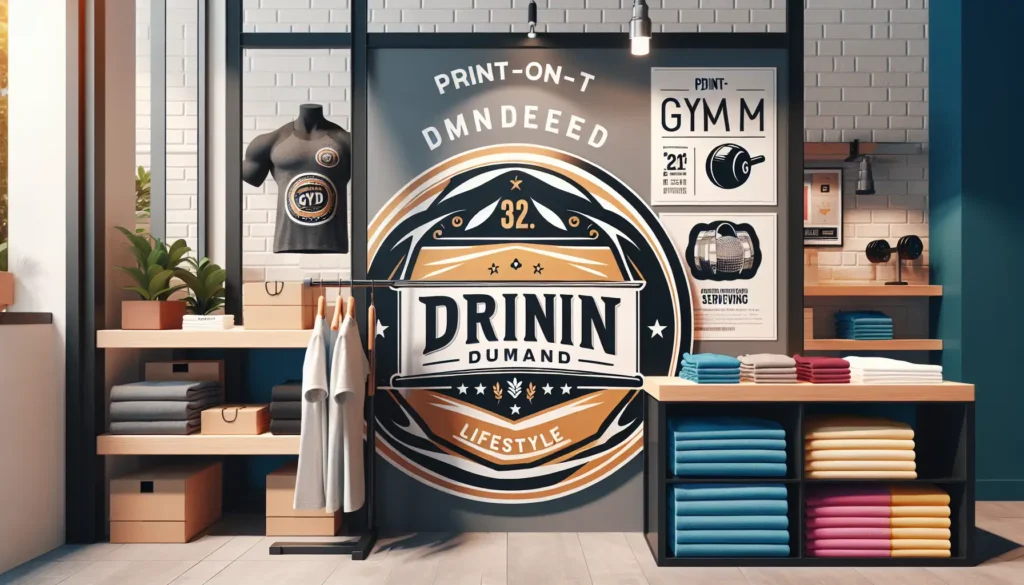Products can be copied, but brands can’t. In the competitive world of print on demand, this simple truth separates thriving businesses from struggling sellers. While anyone can upload a design to a platform and hope for sales, building a recognizable brand creates lasting value that competitors cannot replicate. Strong brands earn 33% more revenue than generic sellers, according to industry research. Therefore, mastering print on demand branding isn’t just an option—it’s essential for long-term success.
The difference between a successful POD business and a forgotten one lies in strategic branding. When customers connect with your brand story, visual identity, and values, they become loyal advocates rather than one-time buyers. Moreover, branded businesses command higher prices, enjoy better customer retention, and build sustainable competitive advantages. This comprehensive guide will teach you to transform your print on demand store from a generic seller into a recognizable brand that customers trust and remember.
Why print on demand branding beats one-off sales
Building a brand strategy for your POD business creates exponentially more value than chasing individual sales. While one-off transactions provide immediate revenue, they offer no foundation for sustainable growth. However, branded businesses develop customer relationships that generate repeat purchases, word-of-mouth marketing, and premium pricing opportunities.
Creates unshakeable customer loyalty
Customer loyalty emerges when people connect emotionally with your brand identity. For example, customers who purchase from a POD brand focused on environmental activism don’t just buy products—they support a cause they believe in. This emotional connection transforms casual buyers into brand ambassadors who actively promote your business to their networks.
Loyalty also manifests through repeat purchases. When customers trust your brand quality and values, they return for new products without extensive research. Furthermore, loyal customers are less price-sensitive, allowing you to maintain healthy profit margins even when competitors slash prices.
Builds higher trust and credibility
Trust becomes your most valuable asset in the crowded POD marketplace. Professional branding signals quality, reliability, and legitimacy to potential customers. Meanwhile, generic sellers struggle to overcome buyer skepticism, especially when selling to first-time customers online.
Consistent branding across all touchpoints reinforces credibility. When your website, social media, packaging, and customer service align with your brand identity, customers perceive your business as established and trustworthy. This trust translates directly into higher conversion rates and larger average order values.
Essential elements of a strong POD brand
Successful print on demand branding requires several interconnected elements working in harmony. Each component reinforces your brand identity while contributing to overall customer experience. Therefore, developing these elements strategically ensures consistent brand recognition across all customer touchpoints.
Memorable logo and visual identity
Your logo serves as the visual cornerstone of your POD brand. It should be simple enough to work at small sizes on products, yet distinctive enough to stand out in crowded marketplaces. Professional logos typically cost between $300-$1,500 when working with experienced designers, though this investment pays dividends through improved brand recognition.
Beyond the logo, establish a comprehensive visual identity system. This includes color palettes, typography choices, and graphic elements that appear consistently across products and marketing materials. For example, a fitness-focused POD brand might use bold, high-contrast colors with strong, angular fonts that convey energy and determination.
Consistent tone and communication style
Your brand voice determines how customers perceive your personality and values. Whether playful and casual or professional and authoritative, consistency in communication builds familiarity and trust. Document your brand voice guidelines, including preferred vocabulary, sentence structure, and emotional tone for different situations.
This consistency extends to product descriptions, social media posts, customer service interactions, and email marketing. When every communication reinforces your brand personality, customers develop stronger emotional connections with your business.
Branded packaging and presentation
Packaging represents your final opportunity to create a memorable brand experience. Custom packaging transforms ordinary deliveries into exciting unboxing experiences that customers often share on social media. Even simple additions like branded stickers, thank-you cards, or tissue paper elevate perceived value.
Consider the complete customer journey when designing packaging elements. From the shipping box to product tags, every detail should reinforce your brand identity and create positive associations with your business.
Storytelling strategies for POD brands
Compelling brand stories differentiate your POD business from countless competitors selling similar products. Stories create emotional connections that transcend price comparisons and feature lists. Moreover, authentic narratives give customers reasons to choose your brand beyond product functionality.
Share your inspiration and journey
Personal stories resonate powerfully with customers seeking authentic connections. Share what inspired you to start your POD business, challenges you’ve overcome, and values that guide your decisions. For instance, a pet-themed POD brand might tell the story of how rescuing a shelter dog inspired designs that celebrate animal adoption.
Document your entrepreneurial journey through blog posts, social media content, and about pages. Customers appreciate transparency and often support businesses whose stories align with their own experiences or aspirations. However, ensure your story remains relevant to your target audience and brand positioning.
Connect to community values and causes
Aligning your brand with meaningful causes creates deeper customer connections while contributing to positive social impact. Choose causes that genuinely reflect your values rather than following trends. This authenticity becomes apparent to customers and strengthens brand credibility.
For example, a POD brand selling outdoor adventure designs might partner with environmental conservation organizations, donating a percentage of profits to forest preservation. This alignment attracts environmentally conscious customers while reinforcing the brand’s outdoor lifestyle positioning.
Examples of successful POD brands
Learning from successful POD brands provides valuable insights into effective branding strategies. These examples demonstrate how focused positioning, consistent messaging, and authentic storytelling create thriving businesses in competitive markets.
Gym and fitness lifestyle brands
Fitness-focused POD brands succeed by tapping into the motivational mindset of their target audience. These brands often feature inspirational quotes, workout-themed graphics, and lifestyle imagery that resonates with fitness enthusiasts. Successful fitness POD brands maintain consistent messaging about determination, self-improvement, and achieving goals.
One notable example focuses exclusively on powerlifting culture, creating designs that speak directly to serious strength athletes. Their branding emphasizes authenticity, using terminology and imagery that demonstrates deep understanding of the powerlifting community. This specialized focus allows them to charge premium prices while building fierce customer loyalty.
Niche hobby communities
Hobby-based POD brands thrive by serving passionate communities with specialized interests. Whether targeting knitting enthusiasts, vintage car collectors, or board game players, these brands succeed through deep community understanding and authentic representation of hobby culture.
A successful example targets the quilting community with designs celebrating traditional patterns, quilting humor, and crafting pride. Their branding reflects the warm, community-oriented nature of quilting culture while offering products that quilters genuinely want to wear and display. This authentic approach has built a loyal customer base that actively promotes the brand within quilting circles.
Common branding mistakes that kill POD success
Understanding branding pitfalls helps you avoid costly mistakes that undermine business growth. Many POD entrepreneurs make these errors unknowingly, wondering why their sales plateau despite quality products and marketing efforts. Therefore, recognizing and avoiding these mistakes becomes crucial for long-term success.
Inconsistent visual branding
Visual inconsistency confuses customers and weakens brand recognition. When your logo, colors, and design style vary dramatically across products and platforms, customers struggle to identify your brand. This confusion reduces trust and makes building brand awareness significantly more difficult.
Common consistency mistakes include using different color schemes for various product lines, changing logo designs frequently, or mixing incompatible design styles. Instead, develop comprehensive brand guidelines that specify exact colors, fonts, and design elements for all applications. Invest time in creating templates that ensure visual consistency across all products and marketing materials.
Constantly switching niches and audiences
Niche-hopping prevents deep brand development and confuses your audience. When you target cat lovers one month, fitness enthusiasts the next, and gardening hobbyists the following month, you never build meaningful connections with any community. This scattered approach dilutes your marketing efforts and prevents the focused expertise that builds trust.
Successful POD brands choose their niche carefully and commit to serving that audience exceptionally well. This focus allows for deep market understanding, authentic community engagement, and specialized product development that generic brands cannot match.
Ignoring customer feedback and community input
Brands that operate in isolation miss valuable opportunities for improvement and growth. Customer feedback reveals preferences, pain points, and opportunities that internal teams might overlook. Moreover, involving customers in brand development creates stronger emotional investment in your success.
Regularly survey customers about their preferences, monitor social media comments, and engage actively with your community. Use this feedback to refine your brand messaging, improve products, and develop new offerings that better serve your audience’s needs.
Building your print on demand branding strategy
Developing a comprehensive branding strategy requires systematic planning and consistent execution. This process involves research, positioning, creative development, and implementation across all business touchpoints. Furthermore, successful strategies evolve based on market feedback while maintaining core brand elements.
Market research and competitor analysis
Begin by thoroughly researching your target market and analyzing successful competitors. Identify gaps in current brand positioning, underserved customer segments, and opportunities for differentiation. This research phase typically requires 2-3 weeks of dedicated effort but provides the foundation for all subsequent branding decisions.
Analyze competitor pricing, messaging, visual styles, and customer engagement strategies. Look for patterns in successful brands while identifying opportunities to position your brand uniquely. Document your findings to reference throughout the brand development process.
Defining your brand positioning
Brand positioning articulates how you want customers to perceive your business relative to competitors. This positioning should be specific, relevant to your target audience, and defensible against competitive threats. For example, positioning as “the most authentic voice in vintage motorcycle culture” provides clear direction for all branding decisions.
Develop a positioning statement that includes your target audience, competitive frame of reference, key benefits, and supporting reasons. This statement guides all creative and strategic decisions while ensuring consistency across team members and external partners.
Implementing your POD brand across platforms
Consistent brand implementation across all platforms reinforces recognition while building trust with potential customers. Each platform offers unique opportunities for brand expression, yet all touchpoints should align with your core brand identity. Therefore, developing platform-specific strategies within your overall brand framework maximizes impact.
E-commerce platform optimization
Your primary sales platform serves as your brand headquarters, requiring careful attention to visual design, user experience, and messaging. Customize your storefront with brand colors, fonts, and imagery that reflect your positioning. Professional e-commerce design typically costs $2,000-$5,000 but significantly impacts conversion rates and brand perception.
Optimize product descriptions with consistent brand voice while incorporating relevant keywords for search visibility. Create compelling about pages that tell your brand story and establish credibility with first-time visitors. Additionally, ensure your checkout process reinforces brand trust through professional design and clear communication.
Social media brand consistency
Social media platforms provide ongoing opportunities for brand reinforcement through regular content sharing. Develop platform-specific content strategies that align with your brand voice while leveraging each platform’s unique strengths. Instagram might showcase product photography and lifestyle imagery, while LinkedIn could focus on industry insights and business stories.
Create content templates and posting schedules that maintain consistent brand presence without overwhelming your audience. Use branded graphics, consistent hashtags, and authentic engagement to build community around your brand values.
Measuring and optimizing your POD brand performance
Brand building requires ongoing measurement and optimization to ensure your efforts generate meaningful business results. Unlike direct marketing campaigns, branding impacts often develop gradually, requiring patience and consistent monitoring. However, tracking the right metrics helps you understand brand performance and identify improvement opportunities.
Key brand performance indicators
Monitor brand awareness through direct traffic to your website, branded search volume, and social media mentions. These metrics indicate whether customers actively seek your brand rather than discovering it through advertising. Additionally, track customer lifetime value, repeat purchase rates, and average order values to measure brand loyalty impact.
Survey customers regularly about brand perception, recall, and recommendation likelihood. Net Promoter Score (NPS) provides valuable insights into customer advocacy, while brand recall surveys measure how well customers remember your brand compared to competitors.
Continuous brand refinement
Use performance data to refine your brand strategy while maintaining core identity elements. Minor adjustments to messaging, visual elements, or positioning can significantly impact results without confusing existing customers. However, avoid major brand overhauls unless performance data clearly indicates fundamental positioning problems.
Test different brand elements through A/B testing on product pages, email campaigns, and social media content. This testing approach provides data-driven insights into which brand expressions resonate most effectively with your target audience.
Advanced print on demand branding techniques
Once you’ve established fundamental branding elements, advanced techniques can further differentiate your POD business and strengthen customer relationships. These strategies require additional investment but often generate substantial returns through increased customer loyalty and premium pricing opportunities.
Community building and engagement
Building genuine communities around your brand creates powerful competitive advantages that are difficult to replicate. Start by identifying where your target customers naturally gather online, then provide valuable content and authentic engagement in those spaces. This approach builds trust and positions your brand as a community leader rather than just another seller.
Consider creating exclusive Facebook groups, Discord servers, or forum spaces where customers can connect with each other and your brand. Moderate these communities actively, sharing valuable content, answering questions, and facilitating meaningful discussions. Community members often become your most loyal customers and effective brand ambassadors.
Influencer partnerships and collaborations
Strategic influencer partnerships can rapidly expand brand awareness within your target market. However, choose influencers whose audiences and values align closely with your brand positioning. Micro-influencers with 10,000-100,000 followers often provide better engagement rates and more authentic endorsements than celebrity influencers.
Develop long-term relationships with select influencers rather than one-off promotional posts. This approach builds more authentic partnerships while providing consistent brand exposure to relevant audiences. Track partnership performance through unique discount codes, affiliate links, or custom landing pages.
Print on demand branding represents your most powerful competitive advantage in an increasingly crowded marketplace. While products can be copied overnight, authentic brands built on genuine customer connections and consistent value delivery cannot be replicated. The strategies outlined in this guide provide a comprehensive framework for transforming your POD business from a generic seller into a recognizable, trusted brand.
Remember that successful branding requires patience, consistency, and ongoing refinement. Start with solid fundamentals—clear positioning, professional visual identity, and authentic storytelling—then gradually implement advanced techniques as your business grows. Monitor your progress through relevant metrics while staying true to your core brand values and customer promises.
The investment in professional branding pays dividends through higher customer loyalty, premium pricing opportunities, and sustainable competitive advantages. Moreover, strong brands weather market changes and competitive pressures more effectively than businesses built solely on product features or pricing.
Start crafting your brand identity today by defining your positioning, developing your visual identity, and creating authentic stories that resonate with your target audience. Your future customers are waiting to discover a brand they can trust, support, and recommend to others. Make sure that brand is yours.








